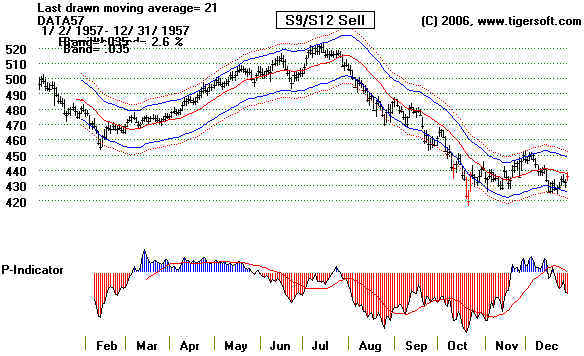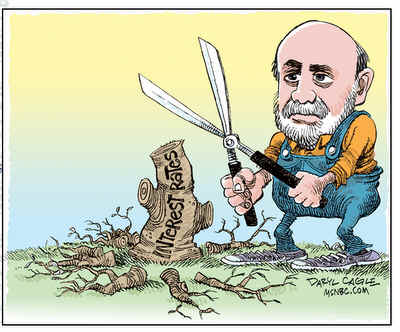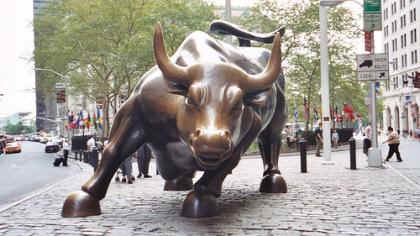|

Who Will Be Proven Right?
The
Monetarists or The Keynesians?
Part 2. (See Part 1 - http://www.tigersoft.com/Tiger-Blogs/Jan-29-2008/index.html
)
 versus
versus

Ben Bernacke
John M. Keynes
Can A Severe
Recession Be Avoided?
Bernacke's cuts of interest rates have been breath-taking. We see very few times in
history when
rates were cut as fast.
People forget that it was the raising of
rates by Fed Chairman Greenspan that
started the awful 2000-2003 bear
market.. He chose to fight stock market speculation in the same way the
Fed had done in 1928 and 1929,
raising interest rates rather than increasing margin requirements. When the
stock market did crash in 2001 and
2002, Greenspan dropped the Discount rates from 6.0% in small 1/2%
and 1/4% steps from 2001 until
November 7, 2002. One has to ask if he had acted more forcefully, more
quickly could the longest bear
market since the Great Depression have been shortened and ameliorated.
Greenspan was always cautious.
He instituted no Discount Rate cut after the 1987 Crash, though the Fed
Funds' rate was dropped.. And
he was late in reacting to the 20% decline in 1998 in the aftermath of
of the collapse of the LT-Hedge
Fund. Bernacks clearly is more aggressive than Greenspan. Bernacke's
academic interest at Princeton was
centered around the monetary mistakes of the Great Depression.

 |
DID GREENSPAN CAUSE
THE CRASH OF 2001-2003?
Discount
Rate
| 11/19/98 to 08/24/99 |
4.50 |
|
| 08/25/99 to 11/17/99 |
4.75 |
|
| 11/18/99 to 02/02/00 |
5.00 |
|
| 02/03/00 to 03/20/00 |
5.25 |
|
| 03/21/00 to 05/17/00 |
5.50 |
|
| 05/18/00 to 01/03/01 |
6.00 |
|
|
Bernacke clearly is much more aggressive than Greenspan. We
might want to study his
 Essays on the Great Depression.
Essays on the Great Depression.
 |
Recent
Discount Rate
Cuts
| 06/29/06 to 08/16/07 |
6.25 |
0 |
| 08/17/07 to 09/17/07 |
5.75 |
0 |
| 09/18/07 to 10/31/07 |
5.25 |
0 |
| 11/01/07 to 12/11/07 |
5.00 |
0 |
| 12/12/07 to 01/21/08 |
4.75 |
0 |
| 01/22/08 to 01/30/08 |
4.00 |
0 |
| 01/31/08 to present |
3.50 |
0 |
|
(Cartoon's source: http://politicalhumor.about.com/od/politicalcartoons/ig/Political-Cartoons/Bernanke-s-Brew.htm
)
Ben Bernacke has followed in the foot-steps of Milton Friedman in believing that business
cycles can be smoothed by timely raising and lower of interest rates. When business
conditions
weaken it is the job of the Federal Reserve to increase the supply of money in the US
economy.
Both
argue that the Great Depression was a direct result of mistaken monetary policies and that
the
inflation of the 1970s resulted because President Nixon wrongly tried to use wage and
price
controls to control inflation.
Bernacke's lecture in March 2004 makes clear his concern that the Fed be a primary agent
in the battle to avoid another great Depression. He begins by contrasting the
severity of the
Great Depression and the deepest post World War II recession. "During the major
contraction phase
of the Depression, between 1929 and 1933, real output in the United States fell nearly 30
percent.
During the same period, according to retrospective studies, the unemployment rate rose
from about
3 percent to nearly 25 percent, and many of those lucky enough to have a job were able to
work
only part-time. For comparison, between 1973 and 1975, in what was perhaps the most severe
U.S.
recession of the World War II era, real output fell 3.4 percent and the unemployment rate
rose from
about 4 percent to about 9 percent." Unlike in the 1970's, prices fell by 10%
in the 1930s. Money
supply decreased by one-third between 1929 and 1933. He praises the book by Friedman
and
Schwartz, A Monetary History of the United States, 1867-1960 (1963) for pointing out a
series of
mistakes by the Federal Reserve in the period 1929 to 1933.
1. The first mistake was the Fed's raising the Discount Rate in 1928 to curb excessive
stock
speculation. The Fed should have dealt with stock speculation differently (Raising
the margin
requirements would have been a better policy choice.) since the economy itself was slowing
down
in
1928. The Fed had lowered rates from 7.0%, starting on 5/10/21, in steps to 3.5% on
9/13/1927.
It
then raised the rates until 2/28/30, four months after the Crash. It sat on its hands
after 9/12/30,
when
the DJI was at 241.20
Date Discount Rate
DJI
9/13/27 3.5%
194.70
2/27/28 4.0%
192.10
4/25/28 4.5%
208.90
5/14/29 5.0%
320.80
9/13/29
381.20
2/8/30 4.5%
271.10
4/15/30 4.0%
293.30
9/12/30 3.5%
241.20
Fed did nothing for the next 3 1/2 years!
--------------------- DJI 1931
-----------------------------------------------------------------------------------------------------

---------------------------- DJI 1932
-----------------------------------------------------------------------------

7/28/32
41.20
2/27/33
50.20
3/16/34 3.0%
102.70
1/8/35 2.5%
105.00
5/14/35 2.0%
114.20
8/24/37 1.5%
182.40
11/23/37
115.80
9/12/39
155.90
3/28/42 1.0%
100.00
4/29/42
94.70
(Source: http://minneapolisfed.org/research/data/us/disc.cfm
)
2. In 1931 and 1932, the Fed chose to protect the Dollar against foreign exchange
speculators
by
rising interest rates, instead of doing all they could to take steps to prevent the
growing number of
bank
failures in the US. There was no Depositors' Insurance. That would have helped a lot
to stem
the
tide of runs on banks. "The Federal Reserve had the power at least to ameliorate the
problems
of
the banks. For example, the Fed could have been more aggressive in lending cash to banks
(taking
their
loans and other investments as collateral), or it could have simply put more cash in
circulation.
Either action would have made it easier for banks to obtain the cash necessary to pay off
depositors,
which
might have stopped bank runs before they resulted in bank closings and failures.
3. Many of the Fed Governors viewed the "Depression as the inevitable and necessary
purging
of
financial excesses built up during the 1920's".
4. Some Governors did not understand that "even though nominal
interest rates were very low,
the
ongoing deflation meant that the real cost of borrowing was very high because any loans
would have
to be
repaid in dollars of much greater value."
The Closest Historical Parallel to 2008 Is 1958
if We Are Considering Rapid Cuts in
Interest Rates.
This Produced A 52% Gain from Its Lows in
21 Months.
Background: The DJI had run up strongly, nearly 100%, from 255.50 on
September 1954 to
521.10 in April
1956. In 1956, a Presidential Election year, ir then went sidewise with two steep
drops in the
Presidential Election year of 1956. But from mid-July 2007, with the DJI at 520, the
market
started turning down.
On October 4th, 1957, the Soviet Union successfully launched Sputnik, the
world's first
artificial satellite. The USSR was seen as ahead of the US in the Space Race.
The US
had announced its own
plan to put up a space satellite in July 1955, but did not succeed until January
31, 1958.
---------------------------------- DJI 1957
-------------------------------------------------------------
. 
.
On 11/22/57 the Discount Rate was dropped from 3.5% to 3.0% It was then
lowered
in three steps to
1.75% by 4/18/58. On 11/22/57 the DJI was at 442.70. On 4/18/58,
it was at 449.30.
It peaked on 8/3/59 at 678.10, a rise of 50.9%.
This was a 50% reduction
in the FED
DISCOUNT rate cut in 4 months.

Next
- The Limits of the FED's Power:
Criticisms of A Monetarism.....
|


 versus
versus










